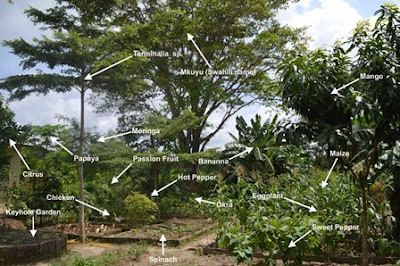PDC LESSON 2.5 DESIGN – VEGETABLE GARDEN
PERMACULTURE COURSE AGRO-ECONOMIC
PDC LESSON 2.5 DESIGN – VEGETABLE GARDEN
A POTAGER GARDEN IS A GOOD WAY TO GROW
Fruits, vegetables, and both medicinal and edible
herbs are grown together with the main incentive to feed the family. A Potager
Garden translates to "For The Soup Pot". These traditional kitchen
gardens date back to France nearly a thousand years ago when it was common for
people to grow their own food and medicine.
Being both beautiful and practical, it is well suited
for small yards. The design structure uses both accessible bed space, as well
as being close to the home. The idea is that you can step into your garden,
with bare toes to grab dinner's ingredients or throw the last of the dish water
on the compost.
If you plan to grow a Potager garden, instead of
arranging your beds in a grid, consider using the space for both beauty and
function. Some beds are vertical, while others are horizontal. Use the fence
line as a trellis, or a hot spot for dwarf fruit trees. However you design it, take
some time to figure out the best use of your space. Keep your pathways tight,
enough to fit a wheelbarrow, and consider how the sun will move in your garden.
Knowing where the sun hits first is great for heat loving vegetables.
Make sure to plan a focal piece in the center of your
garden. A small bird bath, or pool is both beautiful and helpful for pollinator
insects needing a drink. Instead of planting herbs in one area, consider
planting a bit everywhere especially on difficult to grow spaces, like the
edges of beds.
Dwarf fruit trees make sense when you have a small
amount of land and don't want to pick fruit on a ladder. You can plant multiple
dwarf varieties and get a really great harvest in a short period of time using
less space. Not only do they function perfectly in the kitchen garden, they are
beautiful as well.
Both medicinal and edible herbs can be grown in the
Potager garden. I like comfrey, lemon balm, mint, and onions at the base of all
the fruit trees. Plant creeping thyme in your walkways for an aromatic effect.
It makes sense to grow many useful herbs that can help
the process of healing. Calendula, chickweed, and plantain are excellent for
the skin. They can be combined to make healing salves. Lemon balm tea calms the
nervous system and comfrey makes a skin poultice. Make sure to plant your
favorite herbs you love to cook with.
A truly nourishing meal is cooked using ingredients
that I have grown. The recipes that are inspired by a seasonal garden can be
life changing. I have come know that oregano, roasted eggplant and oil combined
is one of the very best parts about summer. And basil at the base of tomatoes
is for both ease of harvest and for the aroma of the greenhouse. So when you
plan a potager, most of all, grow things you love and eat.
Successive harvests and year-round eating from the
garden sounds seemingly simple. Yet it is a skill we have lost. We can all
re-learn these old skills through our efforts. Over time we learn the seeds and
when to plant them. It becomes intuitive as we move along.
A part of traditional gardening is putting back into
the earth whatever we took. Taking care of the soil, we compost. We try to keep
bare soil to the minimum. Where there are no plants, instead of weeding, we
mulch or add a ground cover. We are able to grow food without chemical
fertilizer.
The biggest teaching that the Potager garden teaches
us is that what we consume into our body is more than just through the mouth.
We feed ourselves through our eyes, our noses, and our touch. These senses are
just as necessary as taste. In the Potager garden, we can grow for all senses.
Written by Women Who Farm



Comments
Post a Comment